Moon Lilies: Symbolism, Fragrance, and Nocturnal Magic
Welcome to the magical world of Moon Lily, nature’s evening blossoms. Moon Lilies, also known as night-blooming lilies, are unusual flowers because they bloom under the moon’s soothing glow. These fragile and mysterious blooms have enchanted humans for generations with their beauty and mystery.
We’ll explore Moon Lilies’ mysteries and charm in this essay. We’ll investigate their mythology and cultural symbolism. Moon Lilies’ low-light adaptations will be studied.
Moon Lilies are important in art, literature, and mythology. Join Hint as we study their medicinal powers and examine their numerous varieties. Their association with the moon, attractive smells, and role in attracting nocturnal pollinators will also be examined.
We will help you comprehend Moon Lilies, their beauty, and their significance, whether you’re a gardener, an art or literature fan, or just inquisitive about nature. As we discover the Moon Lily realm, these gorgeous flowers will enchant you.
The Origins of Moon Lilies
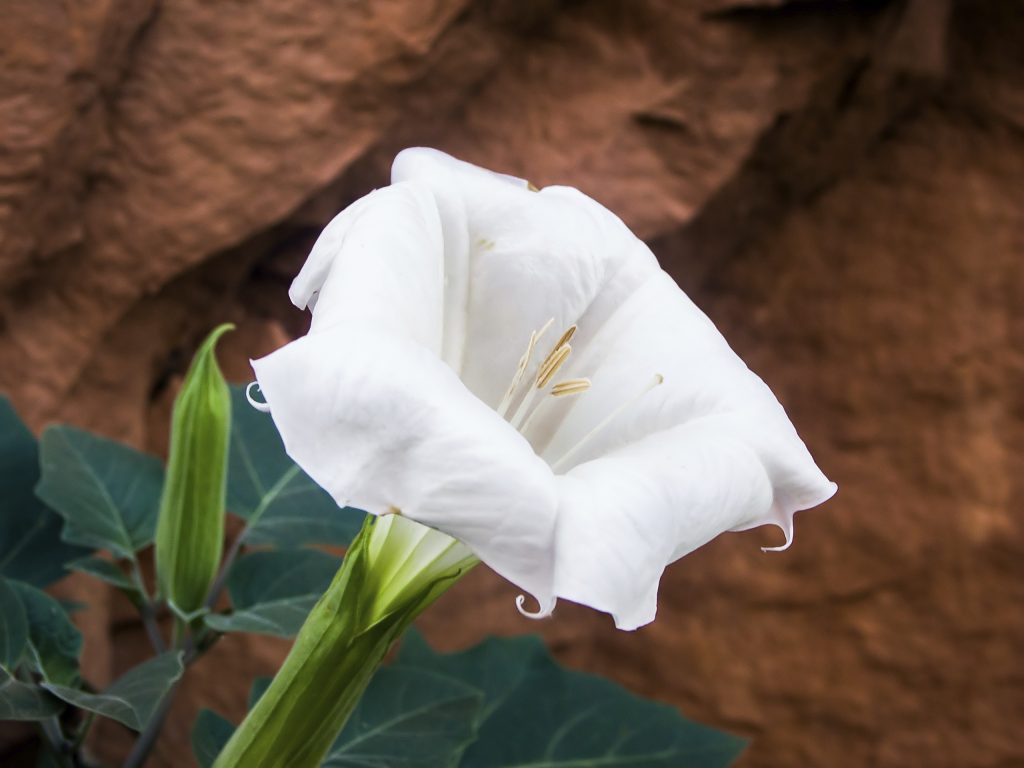
The origins of Moon Lilies are deeply rooted in history, carrying with them a rich tapestry of legends and cultural symbolism. These captivating flowers have captured the imaginations of people across different cultures for centuries. While their precise origins may be shrouded in mystery, their presence in ancient folklore is undeniable.
In various myths and legends, Moon Lilies are often associated with the moon itself, believed to have been touched by its ethereal glow. Some tales speak of the moon showering its radiant light upon the flowers, bestowing upon them their enchanting characteristics. Others believe that Moon Lilies were gifts from celestial beings, brought down to Earth to illuminate the night with their luminous beauty.
These mythical narratives have contributed to the enduring allure of Moon Lilies, making them symbols of grace, elegance, and spiritual significance. Their origins may remain enigmatic, but their ability to inspire and captivate continues to weave an enchanting tale that transcends time and borders.
The Biology of Moon Lilies
Moon Lilies possess fascinating biological characteristics that allow them to thrive in the unique conditions of their nocturnal habitats. These flowers, scientifically known as night-blooming lilies, have evolved specialized adaptations to make the most of their low-light environment.
One key aspect of Moon Lilies’ biology is their ability to open their petals at night and close them during the day. This reversal of the typical flowering pattern is known as nyctinasty and is believed to help protect delicate blooms from excessive heat and sun damage.
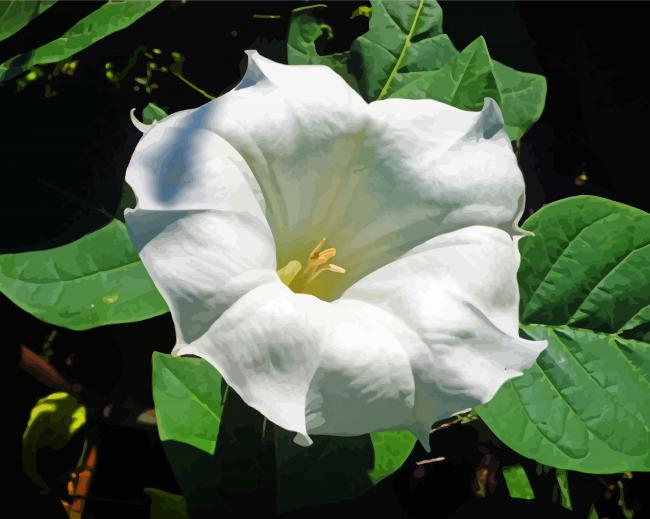
Moon Lilies also exhibit an intriguing trait called phototropism, where their flowers and leaves track the moon’s movement across the night sky. This behavior ensures that the flowers are positioned optimally to receive the moonlight, which they require for photosynthesis during the night.
Another remarkable aspect of their biology is their fragrance. Moon Lilies often emit a captivating scent during their peak bloom, which is thought to attract nocturnal pollinators such as moths and bats. The specific chemical compounds responsible for their alluring fragrance vary among different Moon Lily species.
Furthermore, Moon Lilies are known for their adaptive root systems. Some species have developed bulbs or rhizomes that store nutrients and water, enabling them to survive in diverse soil conditions and withstand periods of drought.
Understanding the biology of Moon Lilies allows us to appreciate their remarkable ability to thrive in darkness and adapt to their surroundings. These adaptations contribute to their unique beauty and make them a truly impressive species in the botanical world.
The Moon Lily Species
Moon Lilies encompass a diverse array of species, each possessing its own unique characteristics and distinctions. Let us take a comprehensive look at the different Moon Lily species, exploring their notable features and highlighting the distinctions that set them apart.
Species Varieties and Traits:
Delicate Elegance: Some Moon Lily species showcase delicate, trumpet-shaped flowers with long, slender petals, exuding an air of elegance.
Color Palette: Moon Lilies exhibit a range of captivating colors, including pure white, creamy yellow, pale pink, and even deep purple hues, adding to their allure.
Petal Patterns: Certain species boast intricate petal patterns, such as speckles or streaks, which further enhance their visual appeal.
Plant Size: Moon Lilies vary in size, with some species growing as compact plants ideal for containers, while others reach impressive heights, creating dramatic displays in gardens.
Blooming Habits and Timing:
Nocturnal Blooms: All Moon Lily species share the remarkable trait of blooming at night, releasing their enchanting fragrance under the moon’s gentle glow.
Flower Longevity: While the exact duration of blooming can differ among species, Moon Lilies generally showcase their blossoms for several nights, adding to their allure.
Flowering Seasons: Different species may have distinct flowering seasons, with some blooming during the summer months, while others showcase their splendor in spring or fall.
Habitat Adaptations:
Ecological Preferences: Moon Lily species exhibit adaptations that allow them to thrive in various habitats, including wetlands, forests, deserts, and meadows.
Soil and Moisture Requirements: Some plants may colonize dry areas, whereas others require damp soil.
Geographic Distribution: Moon Lilies are found across different regions of the world, with certain species endemic to specific areas, adding to their geographical charm.
By exploring the notable features, distinctions, and adaptations of various Moon Lily species, we gain a deeper understanding of their diversity and appreciate the unique beauty that each one brings to the botanical world.
How to Grow Moon Lily
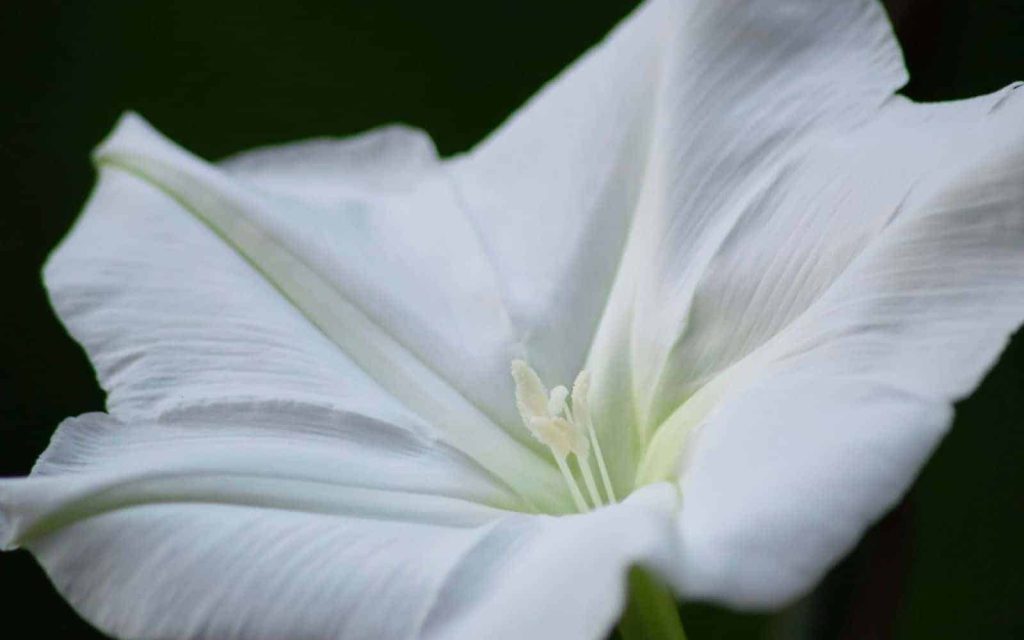
Seed Propagation:
- To propagate Datura wrightii, start by collecting mature seeds from the plant. These seeds are usually found inside spiky, round seed pods.
- After that, extract the seeds from the pods and dry them.
- Prepare a well-draining potting mix or use a seed-starting mix.
- Plant the dry seeds on the soil. They require sunshine to germinate, so gently press them into the soil.
- Keep the soil consistently moist, but avoid overwatering it.
- Find a warm location with indirect sunlight and place the pots there.
- Germination typically takes around 1 to 3 weeks. Once the seedlings have a few sets of true leaves, you can transplant them into individual pots or their desired location in the garden.
Here are 12 simple tips for seed germination that can be applied to grow any type of seed successfully:
Stem Cuttings:
- Choose a healthy stem from the Datura wrightii plant that is not flowering. Ideally, select a stem that is firm and green, but not woody.
- Cut a 4- to 6-inch (10-15 cm) stem segment below a leaf node using a sharp, sterilized knife or pruning shears.
- Remove the lower leaves from the cutting, leaving a few leaves at the top.
- If desired, you can dip the cut end of the cutting into rooting hormone powder to encourage root development. This step is optional.
- Put well-draining soil or peat perlite in a pot.
- Insert the cutting into the soil, burying about half of the stem.
- Thoroughly water the cutting and place it in a warm and bright location with indirect sunlight.
- Occasionally mist the cutting to maintain humidity and prevent it from drying out.
- Roots should start to develop within a few weeks. Once the cutting has established roots, it can be transplanted into a larger container or its final growing spot.
The Conditions for Growing Moon Lilies
Location:
Moon lilies thrive in areas that receive plenty of sunlight, requiring a minimum of 6 hours of direct sun each day. They can also tolerate partial shade, which means they can handle 2 to 6 hours of direct sunlight. For the best growth, it is recommended to provide a southern exposure that offers warmth and bright sunlight. However, in hotter regions, it can be beneficial to provide some shade during midday to prevent the leaves from drying out and ensure they stay hydrated.
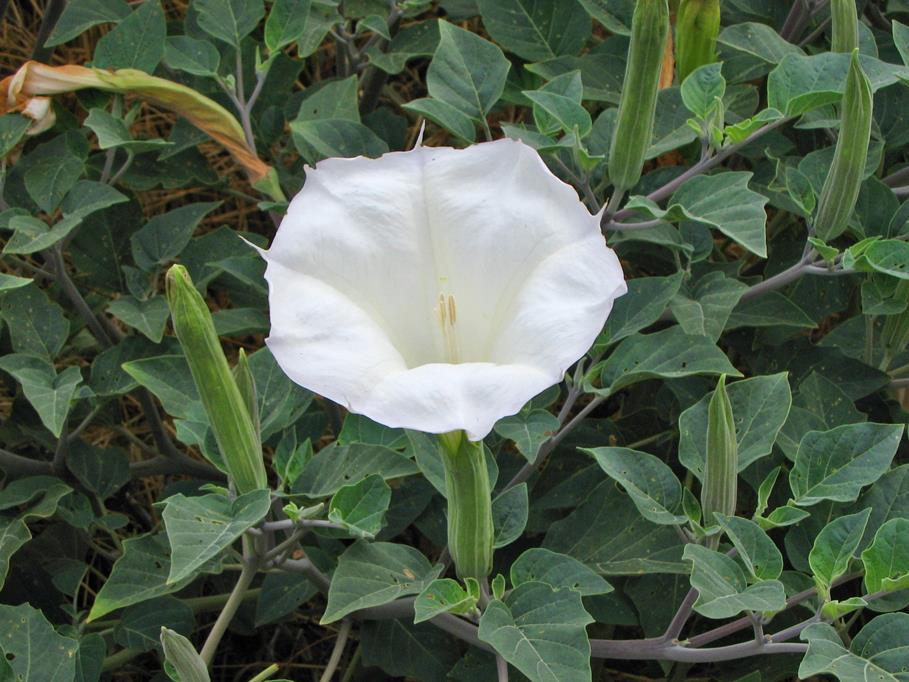
Soil:
Datura wrightii prefers well-draining soil that doesn’t hold excess moisture. Heavy clay soils should be avoided as they can become waterlogged. Instead, choose a soil mix that allows water to flow through freely. A loose, sandy loam or a well-draining cactus/succulent potting mix is suitable for moon lilies.
Water:
To promote optimal growth and vibrant blooms, it is important to water moon lilies regularly while avoiding waterlogged soil. Water the plant only when the topsoil feels slightly dry to the touch. During winter, it is recommended to refrain from watering as natural rainfall usually provides enough moisture.
Standard Moon Lily Care
In sunny, well-drained soil, moon lilies are low-maintenance. However, some occasional care can enhance their appearance and prevent them from becoming weedy or unruly as they age.
During the summer, it’s beneficial to water moon lilies deeply but less frequently, about once every two weeks. This promotes lush growth and abundant flower production. However, it’s important to avoid watering them in winter, as natural rainfall typically provides enough moisture for the plants.
While pruning is not necessary, it can help control the size of the plant if done during the late autumn or winter dormant season. This can be done to maintain a desired shape and prevent overgrowth.
Fertilizer is generally not recommended for moon lilies. Instead, you can side-dress them with compost or apply a layer of mulch around the base of the plants. This helps keep their roots healthy and discourages weed growth, providing some nutrients naturally.
Moon Lilies in Art and Literature
Moon Lilies have left an indelible mark on artistic and literary realms throughout history. Their fascinating beauty and symbolic significance have inspired innumerable artists and writers to include them in their works, creating a rich tapestry of creative expressions. Let’s explore the influence of Moon Lilies in art and literature, delving into their profound impact on human imagination.
Influence in Artistic Expressions:
Paintings and Drawings: Moon Lilies have been a popular subject in various artistic movements, with renowned artists capturing their delicate form and ethereal allure on canvas or paper.
Sculptures and Installations: The elegant shape and symbolism of Moon Lilies have been translated into three-dimensional art forms, adorning gardens, galleries, and public spaces.
Floral Arrangements and Still Life: Moon Lilies frequently find their place in floral arrangements and still-life compositions, adding a touch of enchantment to these artistic representations.
Literary References and Popular Culture:
Poetry and Prose: Moon Lilies have been the muse of poets and writers, serving as a symbol of beauty, mystery, and the passage of time. Countless poems and literary works have woven their imagery into evocative verses and captivating narratives.
Symbolic Significance: Moon Lilies often embody themes such as love, spirituality, femininity, and the ephemeral nature of existence, infusing depth and meaning into literary works.
Cultural References: Moon Lilies have found their way into popular culture, appearing in songs, films, and even as namesakes for fictional characters, becoming enduring symbols of grace and elegance.
The artistic and literary world has embraced Moon Lilies as a source of inspiration, harnessing their evocative qualities to evoke emotions, convey symbolism, and create lasting impressions. Through various artistic expressions and literary references, Moon Lilies continue to captivate our senses and ignite our imagination.
Moon Lilies and the Lunar Connection
Moon Lilies share a deep and intriguing relationship with the moon, their blooming habits intricately tied to the lunar phases. The connection between Moon Lilies and the moon’s influence has sparked curiosity and speculation among enthusiasts and researchers alike. Let’s explore this captivating relationship and delve into the theories behind the nocturnal blooming of Moon Lilies.
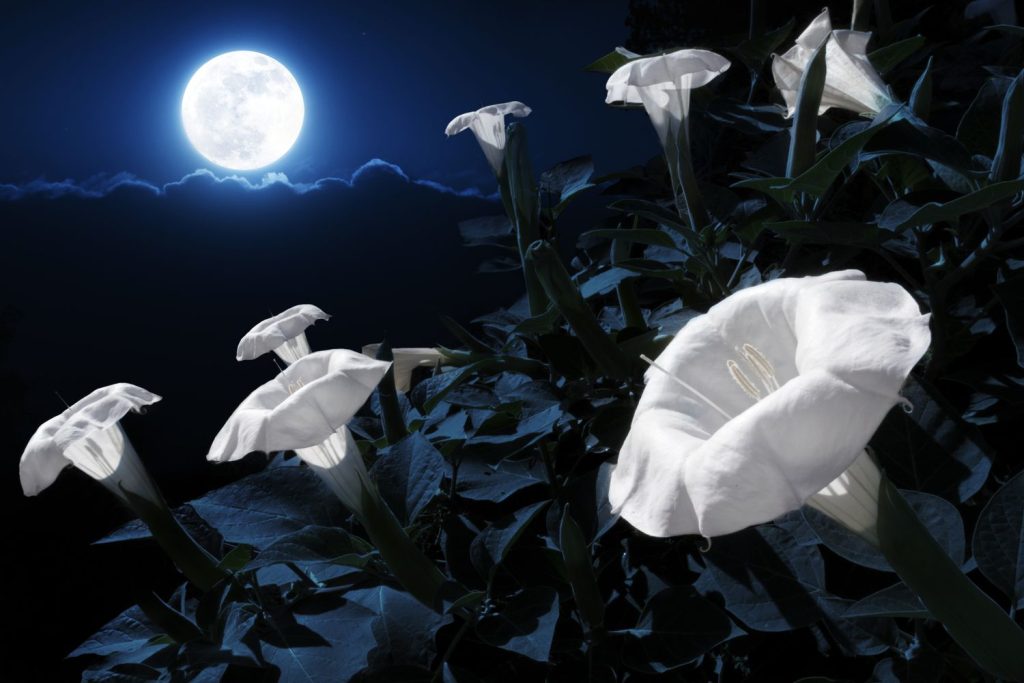
Relationship with Moon’s Phases:
Moon Lilies have a fascinating blossoming synchronicity with the moon’s phases. These beautiful flowers usually bloom during the waxing gibbous or full moon. It’s breathtaking to see their tiny petals open in sync with the celestial cycle.
Moon Lilies are thought to blossom when the moon shines. The moon’s soft light triggers the plants’ beautiful blooms. Moonlight may affect their flower display, lending a sense of cosmic mystery to their natural rhythm.
The Moon Lilies’ tight link with nocturnal pollinators is remarkable. Moths and bats, which are more active at night, are drawn to these ethereal blossoms. Moon Lilies increase their chances of pollination by matching their blooming cycle to the lunar phases.
Theories on Nocturnal Blooming:
Moon Lilies benefit from flowering at night. They escape pollinator competition by blossoming at night. Moon Lilies can avoid competition from daylight flowers by pollinating and reproducing at night.
Their nighttime flowering saves water and energy. Moon Lilies can reduce evaporation and water intake by avoiding the daily sun. This helps them survive in water-scarce situations. Moon Lilies save energy by blossoming at night instead of during the day when sunlight is strongest.
Their flowering matches nighttime pollinators like moths and bats. These animals need low-light adaptations to navigate and forage. Moon Lilies attract nocturnal pollinators by matching their flowering time. The flowers get pollen and the pollinators get nectar.
The Fragrance of Moon Lilies
The fragrance of Moon Lilies adds allure. Under the moonlight, these fragile petals produce an enchanting and intoxicating smell. The fragrance of Moon Lilies is unique and calming.
Aldehydes, esters, and terpenoids make their scent. During peak bloom, these molecules create a delicate, entrancing aroma.
The fragrance of Moon Lilies can transport us to ethereal places and elicit emotions. It has been described as sweet, fresh, and floral, typically with spice or citrus undertones. The subtle perfume evokes moonlit nights and adds a touch of magic.
Beyond human enjoyment, the enchanting fragrance of Moon Lilies has a purpose. The smell attracts evening pollinators like moths and bats. Moon Lilies’ unusual aroma attracts pollinators, assuring their life cycle.
Moon Lilies’ aroma, whether in a moonlit garden or in scented items, is a monument to nature’s olfactory beauty. It reminds us of the delicate relationships between plants and their pollinators and how aroma can transport us to wonderful regions even in the dark.
Moon Lilies as Medicinal Plants
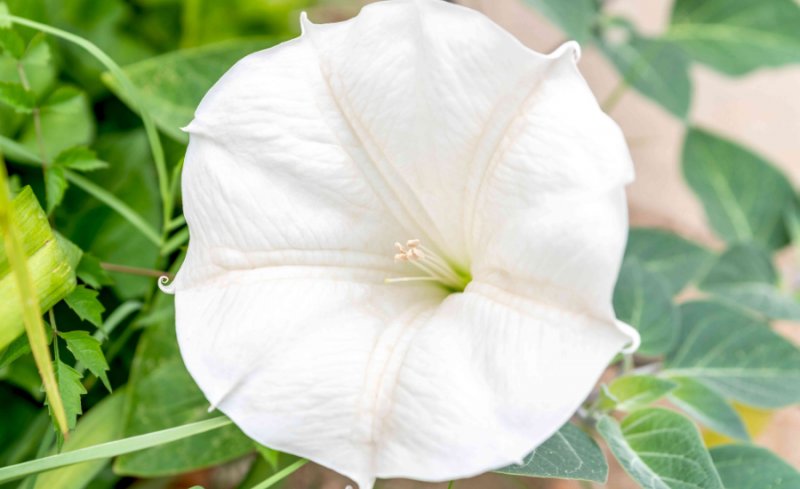
Moon Lilies are known for their beauty and medicinal benefits. Traditional medicine and natural cures use these lovely, fragrant blossoms.
Moon Lilies may be helpful in some cultures. They may reduce redness, swelling, and skin irritation due to their anti-inflammatory characteristics. Rashes, eczema, and small burns can be treated using Moon Lily flower infusions or extracts.
Moon Lilies also relax and sedate. Traditional medicine uses Moon Lily roots or flowers to relax, reduce anxiety, and treat sleep difficulties. Herbal drinks and natural medicines use them for their calming effects.
Moon Lilies may provide health benefits, but utilize them medicinally with caution. Before using Moon Lilies, visit a doctor, as with any herbal medication. To ensure safe and effective use, consider dose, interactions, and sensitivities.
Moon Lilies as a medicine show how nature and health are interconnected. Their seductive presence and healing potential lend another dimension to these amazing blossoms.
Moon Lilies: Conservation and Preservation
Moon Lilies, like other species, confront dangers and obstacles in their natural habitats. However, attempts are being made to preserve these beautiful blossoms. Let’s talk about Moon Lilies’ threats and conservation efforts.
Threats and Challenges:
Understanding Moon Lilies’ dangers is vital to their conservation:
Moon Lilies face habitat loss. Rapid urbanization, agricultural practices, and deforestation destroy and fragment their habitats. Moon Lilies’ populations decline when these habitats shrink and fragment. Another threat is climate change. Climate change can harm Moon Lilies through changing temperatures and rainfall. These fragile flowers thrive and reproduce in certain conditions. Temperature and precipitation changes can upset this delicate biological balance, impacting their ability to flourish and reproduce.
Invasive species threaten Moon Lilies. Invasive plants, which fiercely compete with native vegetation, can outcompete Moon Lilies for nutrients, sunlight, and water. Invasive species can alter Moon Lilies’ natural environments, causing population decline and local extinction.
Moon Lilies must address these risks and implement conservation measures to survive. Protecting and restoring their habitats, limiting climate change, and managing invasive species can help conserve these lovely flowers and their ecosystems.
Conservation Efforts:
Moon Lilies are conserved globally. Moon Lilies and their habitats need protected areas like nature reserves and national parks. These protected places prevent human activity that could harm sensitive ecosystems, allowing Moon Lilies to thrive.
Moon Lily habitats are also being restored. This includes restoring native plant populations, managing invasive species, and promoting sustainable land management. Moon Lilies can survive long-term by restoring their habitat. Moon Lily protection requires public education. Educating the public, local communities, and stakeholders about these rare blooms and their conservation demands fosters a sense of responsibility. Encouraging community conservation and maintaining Moon Lilies and their delicate environments can increase commitment.
Moon Lily populations and habitats must be monitored and researched. Researching population dynamics, distribution, and ecological relationships can inform conservation decisions. Regular monitoring evaluates conservation efforts and allows for adaptive management.
These conservation initiatives and scientists, environmentalists, and conservation organizations aim to safeguard Moon Lilies for future generations. We can protect these beautiful blooms and their delicate ecosystems by addressing their dangers and promoting sustainable practices.
Moon Lilies: A Source of Inspiration
Moon Lilies have long inspired creativity. Artists, writers, and poets have been charmed by their ethereal beauty, seductive scent, and symbolic meaning. With their delicate structure and colorful blooms, these tiny flowers evoke astonishment and sensations that transcend language.
Moon Lilies’ delicate petals and intricate details are painted. Artists have captured their ethereal beauty in many ways. Their light, shadow, varied color palette, and elegant petals inspire artists.
Poetry, music, and literature all feature Moon Lilies. Moon Lilies inspire poets and authors with love, longing, and time. Moonlight, romance, and mystery inspire poetry and fiction.
Moon Lilies inspired fashion, home decor, and architecture. Their delicate elegance inspires clothing, decor, and dreamlike places. Moon Lilies add tranquility to fabric patterns, jewelry, and architecture.
Moon Lilies’ timeless appeal and tremendous impact on human imagination are seen in their inspiration. They awaken our senses, stir our emotions, and take us to a peaceful place. Moon Lilies’ beauty inspires.
Difference Between Moon Lily And Blue Lily
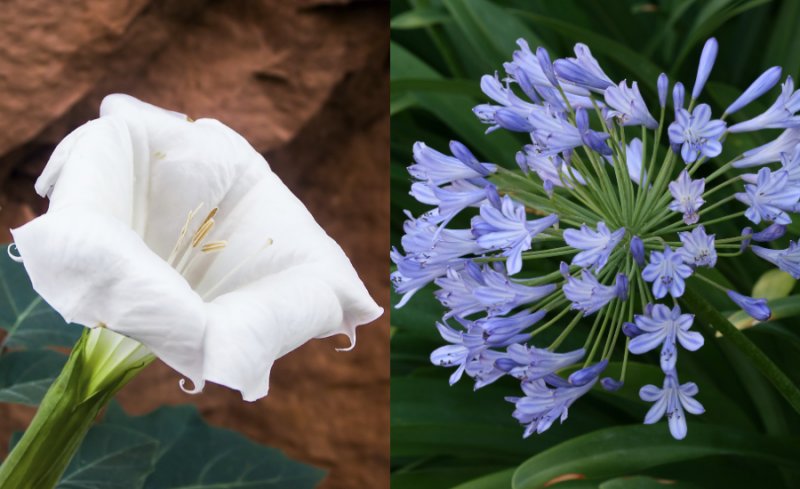
Moon and blue lilies are two beautiful flower kinds with distinct traits. They’re different plants, but they’re stunning. Moon lilies—Zephyranthes—are endemic to North and South America. Blue lilies (Hymenocallis) are native to Central and South America. These flowers demonstrate the tremendous diversity of American floral species, each adding its unique beauty to the botanical tapestry.
| Feature | Moon Lily | Blue Lily |
|---|---|---|
| Scientific name | Zephyranthes | Hymenocallis |
| Bloom time | Late spring to summer | Late summer to fall |
| Flower color | White, yellow, orange, pink | Blue, purple, white |
| Flower size | 2-4 inches in diameter | 3-6 inches in diameter |
| Fragrance | Strong, sweet fragrance | Mild fragrance |
| Plant height | 6-12 inches tall | 12-24 inches tall |
| Hardiness zone | 7-10 | 8-11 |
| Growing conditions | Full sun to partial shade, well-draining soil | Full sun, well-draining soil |
| Pests and diseases | Aphids, spider mites, powdery mildew | Aphids, spider mites, root rot |
| Propagation | Seeds, division | Seeds, division |
Overall, moon lilies and blue lilies are both beautiful and easy-to-grow flowers. However, they have different bloom times, flower colors, fragrances, plant heights, and growing conditions. A moon lily is a fragrant, summer-blooming white or yellow flower. If you want a blue or purple fall blossom, a blue lily may be ideal.
Moon Lilies in Different Environments
Moon Lilies, while frequently associated with peaceful gardens and moonlit vistas, can adapt and thrive in many settings. These resilient and beautiful blooms grow in many habitats.
In natural wetlands, Moon Lilies delicately emerge from ponds and marshes. Their exquisite blooms stand out against the rich green foliage and reflect in the calm waters, creating a peaceful setting.
Moon Lilies grow in a desert oasis, meadows, and grasslands. Limited water and harsh sunlight threaten them here. However, their modifications allow them to save moisture and live in arid environments, showcasing their delicate blooms against a backdrop of golden sand or vivid wildflowers.
Moon Lilies are carefully cultivated in home gardens to replicate their natural beauty. Whether in flowerbeds or pots, they captivate outdoor settings and delight gardeners with their ethereal presence.
Moon Lilies’ adaptability shows its international appeal. In marshes, meadows, and gardens, these intriguing blooms inspire and add magic.
Moon Lilies: A Source of Nighttime Beauty
Moon Lilies possess a captivating allure that is particularly enhanced when they bloom in moonlit landscapes. The combination of their delicate petals and the gentle glow of moonlight creates a mesmerizing scene that enchants all who behold it. Let’s explore the mesmerizing aesthetics of Moon Lilies in moonlit landscapes and the art of capturing their allure through photography.
The Mesmerizing Aesthetics of Moon Lilies in Moonlit Landscapes:
Moon Lilies truly come to life under the ethereal glow of the moon. Their delicate, white petals seem to shimmer in the night, creating an enchanting atmosphere. The contrast between the dark surroundings and the luminous blooms adds to their mystique, making them stand out in moonlit landscapes. The serene beauty of Moon Lilies in these settings evokes a sense of tranquility and wonder, transporting observers to a dreamlike realm.
Capturing the Allure of Moon Lilies through Photography:
Photographers are drawn to the enchanting beauty of Moon Lilies and strive to capture their allure in images. Through careful composition and lighting techniques, photographers aim to convey the delicate elegance and ethereal essence of these flowers. From close-up shots highlighting the intricate details of the petals to expansive landscapes showcasing the interplay of moonlight and Moon Lilies, photography allows us to preserve and share the captivating beauty of these nighttime blooms.
Moon Lilies’ presence in moonlit landscapes offers a unique visual experience that is both tranquil and captivating. Through the art of photography, we can capture and share the enchanting allure of these flowers, allowing their nighttime beauty to inspire and captivate others.
People Also Ask (FAQs)
Here Are Some (FAQs) About Moon Lily:
Q: Are Moon Lilies real flowers?
A: Yes, Moon Lilies are real flowers. They belong to the species Nymphaea caerulea, also known as the Blue Egyptian Water Lily or Blue Lotus. It’s worth mentioning that “Moon Lily” can also refer to other night-blooming flowers.
Q: Do Moon Lilies only bloom at night?
A: Yes, Moon Lilies are known for their nocturnal blooming habits. They typically open their delicate petals during the evening and remain in full bloom throughout the night. By the morning, their blooms begin to close, and they often retreat beneath the water’s surface.
Q: Where are Moon Lilies typically found?
A: Moon Lilies are native to various regions, including parts of Africa, Asia, and Australia. Ponds, marshes, and slow-moving streams are common habitats. Some species of Moon Lilies can also be cultivated in garden ponds or containers.
Q: Are Moon Lilies fragrant?
A: Yes, Moon Lilies are known for their enchanting fragrance. Especially at night, these flowers emit a lovely, fresh, and fragrant aroma. The fragrance adds to their allure and enhances the sensory experience of being in their presence.
Q: Can Moon Lilies be grown in home gardens?
A: Yes, certain species of Moon Lilies can be grown in home gardens, particularly in ponds or water features. It’s important to provide them with the right conditions, including ample sunlight, appropriate water depth, and nutrient-rich soil. Consult a gardening expert or local nursery for guidance on specific Moon Lily species suitable for your region.
Q: Are Moon Lilies toxic to pets?
A: Yes, Moon Lilies can be toxic to pets, particularly to cats. Ingesting any part of the plant, including leaves, blossoms, or roots, can cause vomiting, lack of appetite, and kidney damage. It’s essential to keep Moon Lilies out of reach of pets and seek veterinary attention if ingestion occurs.
Q: Can Moon Lilies be used for medicinal purposes?
A: Moon Lilies have been historically associated with various medicinal uses in traditional practices. However, scientific research on Moon Lilies’ therapeutic qualities and safety is limited. Consult a healthcare professional before using Moon Lilies or any plant-based remedies for medicinal purposes.
Conclusion
Moon Lilies’ exquisite beauty and enchantment have enchanted people across cultures and generations. These flowers inspire astonishment with their hypnotic beauty in moonlit landscapes and symbolic meaning in art and literature. This article covered Moon Lilies’ biology, species, cultural importance, and moon connection. We studied their therapeutic potential, adaptation to varied settings, and conservation. Moon Lilies demonstrate nature’s exquisite beauty-fragility balance. Their nighttime flowering and enticing scent invite us to appreciate moonlight magic. We must conserve Moon Lilies as we learn more about them. To preserve their ethereal presence for future generations, we must maintain their natural habitats, increase awareness, and support sustainable practices. Moon Lilies symbolize beauty, peace, and the complex relationship between nature and human creation. Let us admire Moon Lilies and enjoy the enchantment they offer to our life, reminding us of the eternal beauty hidden in the delicate petals that bloom under the moon’s kind gaze.
Stay in touch to get more updates & alerts on Hint! Thank you






